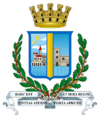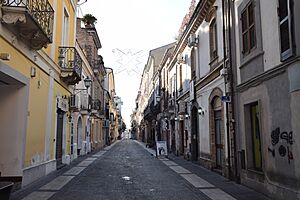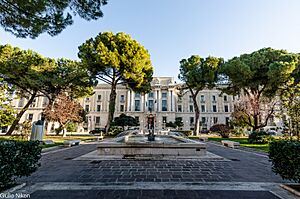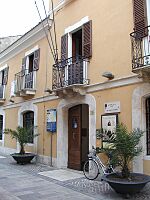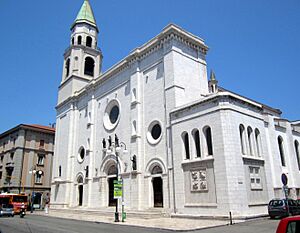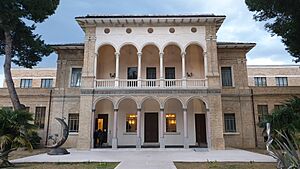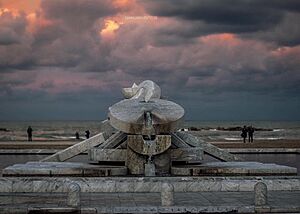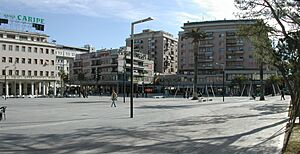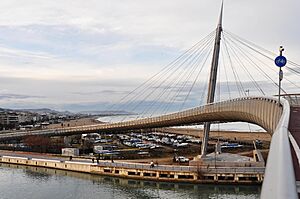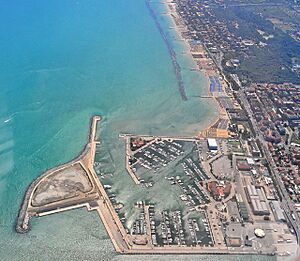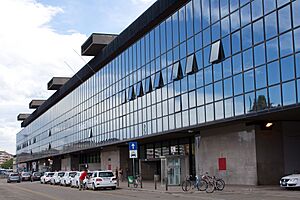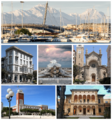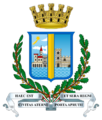Pescara facts for kids
Quick facts for kids
Pescara
Piscàrë (Neapolitan)
|
|||
|---|---|---|---|
| Città di Pescara | |||
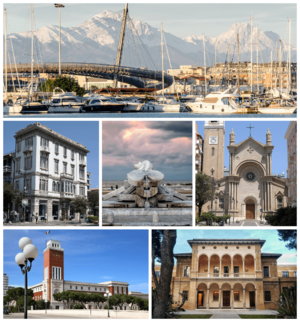
Top: port of Pescara and Gran Sasso d'Italia
Centre: Palazzo Imperato; Fountain La Nave; and Church of the Sacred Heart Bottom: Palazzo di Città; and Aurum Museum |
|||
|
|||
| Motto(s):
HÆC EST CIVITAS ATERNI PORTA APRUTII ET SERA REGNI (Latin)
"This is the city of Aternum, gate of Abruzzi and border of the Kingdom" |
|||
| Country | Italy | ||
| Region | Abruzzo | ||
| Province | Pescara (PE) | ||
| Founded | 1811 | ||
| Frazioni | San Silvestro | ||
| Area | |||
| • Total | 34.36 km2 (13.27 sq mi) | ||
| Highest elevation | 180 m (590 ft) | ||
| Lowest elevation | 0 m (0 ft) | ||
| Population
(30 September 2018)
|
|||
| • Total | 119,554 | ||
| • Density | 3,479.5/km2 (9,011.7/sq mi) | ||
| Demonym(s) | Pescaresi | ||
| Time zone | UTC+1 (CET) | ||
| • Summer (DST) | UTC+2 (CEST) | ||
| Postal code |
65100
|
||
| Dialing code | 085 | ||
| Patron saint | Saint Cetteus | ||
| Saint day | 10 October | ||
Pescara is a lively city in the Abruzzo region of Italy. It's the capital of the province of Pescara and the biggest city in Abruzzo. About 118,657 people live here (as of 2023), and if you count the areas around it, the number goes up to 350,000!
Pescara sits right on the Adriatic Sea coast, where the River Aterno-Pescara meets the sea. The city you see today was created in 1927. It joined two older towns: the Pescara fortress area (south of the river) and Castellamare Adriatico (north of the river).
The main shopping street is Corso Umberto I. It connects two big squares: Piazza della Repubblica and Piazza Primo Maggio by the sea. This area, along with Corso Vittorio Emanuele II and Via Nicola Fabrizi, is a popular spot for shops. If you're looking for nightlife, Corso Manthoné in old Pescara used to be the place to be. The city hall and government offices are in Piazza Italia, close to the river. There's also a business area nearby and a Marina (a place for boats) right next to the river's mouth. Pescara is easy to get to, with its own Abruzzo Airport and a major port, the Port of Pescara, which is great for tourists.
Contents
Exploring Pescara's Location
Pescara is located at sea level on the Adriatic Sea coast. It grew over centuries around the mouth of the Aterno-Pescara River because it was a great spot for trade. The coast here is flat and sandy, with a long beach stretching north and south of the river. In some parts, the beach is as wide as 140 meters (about 153 yards)! There used to be many pine forests along the coast, but now only a small one remains in the north. A larger one is protected in the Nature Reserve Pineta Dannunziana to the south.
The city is mostly flat, spreading out along the river valley and the coast. However, Pescara is also growing into the nearby hills to the northwest and southwest. People have lived in these hills since the Stone Age! The city also has a lot of underground water, which can rise or fall by about a meter, especially in spring when mountain snow melts.
A cool fact about Pescara is how close it is to the mountains. You can drive to the ski slopes of Passo Lanciano in just 30 minutes!
Pescara's Weather
Pescara has a climate that's a mix of humid subtropical climate and Mediterranean climate. This means it has hot summers and cool winters. Even though it's a coastal city, the nearby mountains like the Maiella and Gran Sasso affect its weather.
- Temperatures: The average temperature is around 7°C (45°F) in January (the coldest month) and 24.5°C (76°F) in July (the warmest month). The coldest it's ever been was -13°C (9°F) in 1979, and the hottest was 45°C (113°F) in 2007!
- Rain: Pescara doesn't get a lot of rain, about 676 mm (26.6 inches) per year. Most of the rain falls in late autumn.
- Winds: When a southwesterly wind (called a Foehn wind) blows, it can reach speeds of 100 km/h (62 mph). This wind makes the temperature go up suddenly and the air get very dry. Sometimes, winters can have days where the temperature goes above 20°C (68°F) because of this wind. Pescara has about 35 days a year where the temperature drops below 0°C (32°F).
- Winter Weather: Winds from the northeast can bring rain, and sometimes even snow from Siberia. Heavy snowfalls happen about every 3-4 years.
- Summer Weather: Summers are usually sunny and stable. Thanks to the sea breeze, temperatures rarely go above 35°C (95°F), unless a strong southwesterly wind (called a Libeccio) is blowing. Both in summer and winter, high humidity can cause mist or haze in the mornings and evenings.
| Climate data for Pescara, 1981–2010 normals | |||||||||||||
|---|---|---|---|---|---|---|---|---|---|---|---|---|---|
| Month | Jan | Feb | Mar | Apr | May | Jun | Jul | Aug | Sep | Oct | Nov | Dec | Year |
| Mean daily maximum °C (°F) | 11.4 (52.5) |
11.8 (53.2) |
14.7 (58.5) |
18.1 (64.6) |
23.1 (73.6) |
27.0 (80.6) |
29.7 (85.5) |
29.5 (85.1) |
25.9 (78.6) |
21.3 (70.3) |
16.1 (61.0) |
12.7 (54.9) |
20.1 (68.2) |
| Daily mean °C (°F) | 6.5 (43.7) |
6.8 (44.2) |
9.2 (48.6) |
12.6 (54.7) |
17.2 (63.0) |
21.0 (69.8) |
23.6 (74.5) |
23.7 (74.7) |
20.1 (68.2) |
16.0 (60.8) |
11.1 (52.0) |
7.9 (46.2) |
14.6 (58.4) |
| Mean daily minimum °C (°F) | 1.5 (34.7) |
1.7 (35.1) |
3.8 (38.8) |
7.1 (44.8) |
11.3 (52.3) |
15.0 (59.0) |
17.4 (63.3) |
18.0 (64.4) |
14.3 (57.7) |
10.8 (51.4) |
6.1 (43.0) |
3.2 (37.8) |
9.2 (48.5) |
| Average precipitation mm (inches) | 49.6 (1.95) |
46.2 (1.82) |
54.6 (2.15) |
46.0 (1.81) |
30.6 (1.20) |
47.2 (1.86) |
31.1 (1.22) |
41.6 (1.64) |
63.0 (2.48) |
69.0 (2.72) |
85.0 (3.35) |
75.3 (2.96) |
639.2 (25.16) |
| Average precipitation days | 5.3 | 5.5 | 5.8 | 5.4 | 4.5 | 5 | 3.1 | 3.9 | 5.1 | 6.2 | 7.5 | 7.5 | 64.8 |
| Average dew point °C (°F) | 0.7 (33.3) |
0.5 (32.9) |
2.8 (37.0) |
6.2 (43.2) |
10.6 (51.1) |
14.2 (57.6) |
15.9 (60.6) |
16.6 (61.9) |
13.4 (56.1) |
10.2 (50.4) |
5.9 (42.6) |
2.4 (36.3) |
8.3 (46.9) |
| Source: NOAA | |||||||||||||
| Climate data for Pescara (Abruzzo Airport), elevation: 11 m or 36 ft, 1961–1990 normals | |||||||||||||
|---|---|---|---|---|---|---|---|---|---|---|---|---|---|
| Month | Jan | Feb | Mar | Apr | May | Jun | Jul | Aug | Sep | Oct | Nov | Dec | Year |
| Mean daily maximum °C (°F) | 10.5 (50.9) |
11.6 (52.9) |
14.1 (57.4) |
17.8 (64.0) |
22.2 (72.0) |
26.0 (78.8) |
28.9 (84.0) |
28.6 (83.5) |
25.4 (77.7) |
20.5 (68.9) |
15.7 (60.3) |
11.8 (53.2) |
19.4 (67.0) |
| Daily mean °C (°F) | 6.1 (43.0) |
7.1 (44.8) |
9.2 (48.6) |
12.4 (54.3) |
16.6 (61.9) |
20.4 (68.7) |
23.0 (73.4) |
22.9 (73.2) |
19.9 (67.8) |
15.5 (59.9) |
11.0 (51.8) |
7.5 (45.5) |
14.3 (57.7) |
| Mean daily minimum °C (°F) | 1.7 (35.1) |
2.6 (36.7) |
4.4 (39.9) |
7.0 (44.6) |
11.0 (51.8) |
14.7 (58.5) |
17.1 (62.8) |
17.1 (62.8) |
14.4 (57.9) |
10.6 (51.1) |
6.4 (43.5) |
3.2 (37.8) |
9.2 (48.5) |
| Average precipitation mm (inches) | 54.7 (2.15) |
52.6 (2.07) |
62.9 (2.48) |
55.3 (2.18) |
34.6 (1.36) |
43.9 (1.73) |
33.8 (1.33) |
53.7 (2.11) |
61.2 (2.41) |
73.5 (2.89) |
71.3 (2.81) |
76.8 (3.02) |
674.3 (26.54) |
| Average relative humidity (%) | 74 | 73 | 72 | 71 | 72 | 70 | 69 | 71 | 72 | 75 | 76 | 76 | 73 |
| Mean monthly sunshine hours | 96.1 | 109.2 | 151.9 | 192.0 | 241.8 | 261.0 | 303.8 | 275.9 | 219.0 | 170.5 | 111.0 | 89.9 | 2,222.1 |
| Mean daily sunshine hours | 3.1 | 3.9 | 4.9 | 6.4 | 7.8 | 8.7 | 9.8 | 8.9 | 7.3 | 5.5 | 3.7 | 2.9 | 6.1 |
| Source: NOAA | |||||||||||||
Pescara's Past: A Quick Look
Pescara is very old, even older than the Roman Empire! It started as a port for local tribes like the Vestini and Marrucini. They used it to trade with people from the East. The town and river were called Aternum. It was connected to Rome by important roads like the Via Claudia Valeria and the Via Tiburtina. A big temple called Jovis Aternium was here. Pescara was a key port for trading with the eastern parts of the Roman Empire.
In the Middle Ages, the city was destroyed by the Lombards in 597. Saint Cetteus, who is now the city's patron saint, was a bishop in the 6th century. Legend says he was thrown off a bridge with a stone around his neck, but his body floated all the way to Pescara!
By 1095, Pescara was a fishing village with some important buildings and churches. In 1140, Roger of Sicily took over, and for a while, the town was often destroyed by armies fighting in the Kingdom of Sicily. The name Piscaria, meaning "full of fish," was first used around this time. Many different rulers controlled Pescara, including Rainaldo Orsini and Louis of Savoy. A king's representative, Francesco del Borgo, built a fortress and a tower here. Later, the D'Avalos family ruled.
In 1424, a famous soldier named Muzio Attendolo died in Pescara. Another adventurer, Jacopo Caldora, captured the town in 1435 and 1439. In the years that followed, Pescara was attacked many times by the Venetians. Later, when it was part of the Spanish Kingdom of Naples, it became a very strong fortress.
In 1566, a huge fleet of 105 Turk ships attacked Pescara. The city fought back bravely, and the Ottomans could only damage the areas around it.
At the start of the 18th century, Pescara had about 3,000 people. Half of them lived in Castellammare, a small part of the fortress. In 1707, Austrian troops attacked, led by the Count of Wallis. The town, led by Giovanni Girolamo II Acquaviva, held out for two months before giving up.
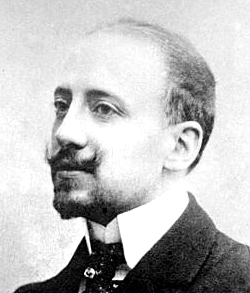
Pescara was always part of the Kingdom of Naples, except for a short time during the Republic of Naples (1798–99). The town was attacked by forces supporting the old rulers. In 1800, French troops took Pescara, and it became an important military base for Joseph Bonaparte. Castellammare, which now had 3,000 people, became its own town.
In 1814, a secret society called the Carboneria in Pescara rebelled against Joachim Murat. On May 15, 1815, the king signed one of the first constitutions of the Italian Risorgimento here. After this, Pescara became known for having one of the worst prisons of the old rulers. After a big flood in 1853, Pescara was freed in 1860 by Giuseppe Garibaldi's friend Clemente De Caesaris. Seven years later, the fortress was taken apart.
Over the next sixty years, Pescara was part of the Province of Chieti. Then, it joined with the nearby town of Castellammare Adriatico and became the biggest city in its region. The new city was heavily damaged during World War II when the Allies bombed it to stop German supplies. Since then, it has been rebuilt and is now a very modern coastal city in Italy.
Places to See in Pescara
The city is split into two parts by the river.
The old part of the city is on the south side of the river. This is where the Piazzaforte (fortified town) used to be, which was a military stronghold. Here you can find the Bagno Borbonico. This was an old prison built starting in 1510 by order of Charles V. It even included parts of the old Norman and Byzantine city walls! Today, this building is home to the Museum of the Abruzzi people. This museum shows 4,000 years of history of the people from Abruzzo through 13 different rooms.
In the historic center, you can also see the houses where famous writers Gabriele D'Annunzio and Ennio Flaiano were born. The San Cetteo Cathedral is also here, built between 1933 and 1938.
On the north side of the river is Piazza Italia (Italy Square). The City Hall and the Government Building (where the Province of Pescara has its offices) are located here. Both were built during the Fascist era in a style called fascist rationalist style and designed by architect Vincenzo Pilotti. Pilotti designed many of the city's public buildings, including the local Chamber of Commerce, the "G. D'Annunzio" high school, and the old court building (which is now a museum).
In the very south of the city, near the Nature Reserve Pineta Dannunziana and the beach, there's a beautiful area with Art Nouveau villas. These were designed in 1912 by Antonino Liberi. You can also find the Aurum here. It was first a social club, then a liquor factory, and now it's a public space used for many different things.
In 2007, the Ponte del Mare was built. This is the longest bridge in Italy for people walking and cycling!
On the northern waterfront, near Salotto Square (the city's main square), you'll see a sculpture called La Nave (The Ship) by Pietro Cascella.
Pescara's Economy
Pescara is the biggest city in the Abruzzo region. It's also one of the top ten centers for business, trade, and tourism on the Adriatic Sea coast. Pescara has a shoreline that stretches for over 20 kilometers (about 12 miles), making it a very popular seaside resort in the summer. To protect the shore from erosion, many breakwaters (large rock barriers) have been placed in the sea close to the beach.
Some important companies have their main offices in Pescara, like De Cecco (a food company) and Fater S.p.a., which is a joint company with Angelini Group and Procter & Gamble.
Culture in Pescara
Every July, Pescara hosts an international jazz festival called Pescara Jazz. It was the first summer festival in Italy dedicated to jazz music. Since 1969, it has become one of the most important jazz festivals in Europe.
Every year, usually between June and July, the city also holds the Flaiano Prizes. This is one of Italy's international film festivals.
Pescara is the birthplace of famous Italian writers Gabriele D'Annunzio and Ennio Flaiano. Also, Vittoria Colonna was once the marchioness (a type of noblewoman) of Pescara.
Learning in Pescara
Pescara and Chieti are home to the G. d'Annunzio University. In Pescara, you'll find departments for Architecture, Economics, Business Administration, and Modern Languages, among others. Chieti has departments for Medicine, Sciences, Humanities, and Engineering. In 2011, the university had about 31,257 students.
Since 2009, a branch of the Rome ISIA (a design school) has been in Pescara. It trains students in industrial design.
In the city center, you can also find the headquarters of ICRANet. This is an international organization that supports research in astrophysics (the study of space and stars) and related fields.
Sports in Pescara
Pescara has a football team called Delfino Pescara 1936. In June 2012, they were promoted to Serie A, which is the highest football league in Italy. Pescara Calcio has played 38 seasons in the second-highest league and 7 seasons in Serie A, especially in the 1980s and 90s.
Pescara hosted the 2009 Mediterranean Games, winning against cities like Rijeka, Croatia and Patras, Greece. In 2015, from August 28 to September 6, the very first 2015 Mediterranean Beach Games were held in the city.
Between 1924 and 1961, Pescara was home to the Coppa Acerbo car race. In 1957, this race was even part of the World Championship of Drivers.
Since 2011, the Italian version of the Ironman 70.3 competition takes place in Pescara. The city was chosen because its landscape is perfect for a race that starts in the sea, goes towards the mountains, and finishes in the city center.
Getting Around Pescara
Pescara has many ways to get around, and its location is great for road travel.
Motorways
Two major European roads cross the area between Pescara and Chieti: the autostrada A14 (Italy) (from Bologna to Taranto) and the autostrada A25 (Italy) (from Torano to Pescara). These roads connect to the local bypass system.
Airport
Pescara has an international airport called Abruzzo Airport (Aeroporto di Pescara). It connects the whole region to many cities in Italy and Europe, like Barcelona, Brussels, Frankfurt, London, Paris, and Milan.
From the bus stop in front of the railway station, there's a daily bus service by ITA Airways to and from Rome Fiumicino Airport. This started in December 2022 and helps people connect with the airline's main hub.
Port
Pescara has the Port of Pescara, which is used for fishing, private boats (yachting), cargo, and passenger services. In the summer, ferries and hydrofoils (fast boats) go to Croatia, mainly to Split and islands in central Dalmatia. However, these often leave from the larger Port of Ortona.
Rail
The city has four railway stations. Pescara Centrale railway station is the main and largest one in Abruzzo. It's also one of the biggest railway stations in Italy without a train terminal. It connects Pescara with major Italian cities like Rome, Milan, Turin, Bologna, Bari, Ancona, and Trieste. The other stations are Pescara Porta Nuova, Pescara Tribunale, and Pescara San Marco.
Bus
Pescara has several bus lines operated by TUA (Società unica abruzzese di trasporto). There's a direct bus line to Roma Tiburtina (Rome) from Pescara Centrale, which takes about two and a half hours.
Trolleybus
A new trolleybus system is planned to start running soon. The first route is 8 kilometers (about 5 miles) long. It connects the city center, including the Pescara Centrale railway station, with Montesilvano. New trolleybuses have arrived and are being tested. Service might start in 2023 or 2024. There are also plans to extend the line to the Abruzzo International Airport and Parcheggio Sud in the future.
Famous People from Pescara
- Federico Caffè (1914–1987), an economist
- Andrea Caldarelli (born 1990), a racing driver
- Giada Colagrande (born 1975), an actress and film director
- Gabriele D'Annunzio (1863–1938), a famous poet, novelist, and politician
- Ildebrando D'Arcangelo (born 1969), an opera singer
- Giovanni De Benedictis (born 1968), a retired race walker
- Eusebio Di Francesco (born 1969), a Football Manager
- Ennio Flaiano (1910–1972), a screenwriter, novelist, and journalist
- Simone Iacone (born 1984), a racing driver
- Francesco Panzieri (born 1985), a visual effects artist
- Stefano Pessina (born 1941), a businessman and Executive Chairman of Alliance Boots
- Stefano Prizio (born 1988), a footballer
- Sara Serraiocco (born 1990), an actress
- Floria Sigismondi (born 1965), a Canadian photographer and director
- Enzo Trulli (born 2005), a racing driver, son of Jarno Trulli
- Jarno Trulli (born 1974), a former Formula One driver
- Marco Verratti (born 1992), an Italian footballer
Pescara's Twin Cities
Pescara has special friendships with other cities around the world, called "twin towns" or "sister cities":
 Arcachon, France
Arcachon, France Miami Beach, U.S.
Miami Beach, U.S. Lima, Peru
Lima, Peru Split, Croatia
Split, Croatia Brescia, Italy
Brescia, Italy Casale Monferrato, Italy
Casale Monferrato, Italy
Images for kids
See also
 In Spanish: Pescara para niños
In Spanish: Pescara para niños



